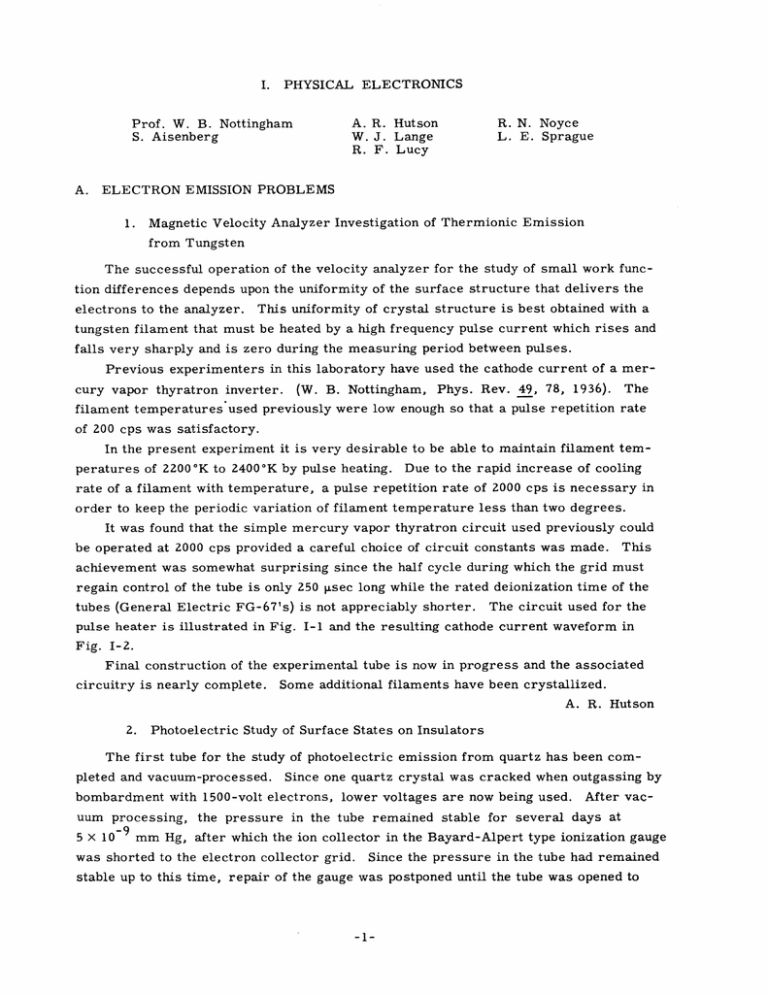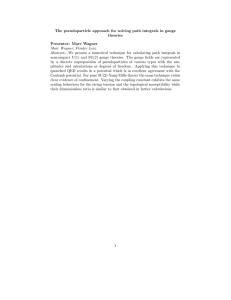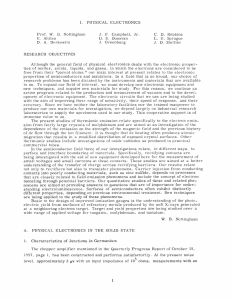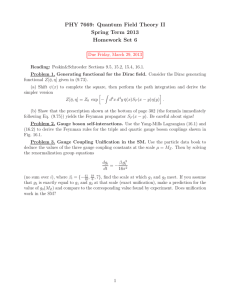I. PHYSICAL ELECTRONICS R. N. Noyce
advertisement

I. PHYSICAL ELECTRONICS A. R. Hutson W. J. Lange R. F. Lucy Prof. W. B. Nottingham S. Aisenberg A. R. N. Noyce L. E. Sprague ELECTRON EMISSION PROBLEMS 1. Magnetic Velocity Analyzer Investigation of Thermionic Emission from Tungsten The successful operation of the velocity analyzer for the study of small work function differences depends upon the uniformity of the surface structure that delivers the electrons to the analyzer. This uniformity of crystal structure is best obtained with a tungsten filament that must be heated by a high frequency pulse current which rises and falls very sharply and is zero during the measuring period between pulses. Previous experimenters in this laboratory have used the cathode current of a mercury vapor thyratron inverter. (W. B. Nottingham, The Phys. Rev. 49, 78, 1936). filament temperatures used previously were low enough so that a pulse repetition rate of 200 cps was satisfactory. In the present experiment it is very desirable to be able to maintain filament temperatures of 2200 0 K to 2400'K by pulse heating. Due to the rapid increase of cooling rate of a filament with temperature, a pulse repetition rate of 2000 cps is necessary in order to keep the periodic variation of filament temperature less than two degrees. It was found that the simple mercury vapor thyratron circuit used previously could be operated at 2000 cps provided a careful choice of circuit constants was made. This achievement was somewhat surprising since the half cycle during which the grid must regain control of the tube is only 250 psec long while the rated deionization time of the tubes (General Electric FG-67's) is not appreciably shorter. The circuit used for the pulse heater is illustrated in Fig. I-1 and the resulting cathode current waveform in Fig. 1-2. Final construction of the experimental tube is now in progress and the associated circuitry is nearly complete. Some additional filaments have been crystallized. A. R. Hutson 2. Photoelectric Study of Surface States on Insulators The first tube for the study of photoelectric emission from quartz has been completed and vacuum-processed. Since one quartz crystal was cracked when outgassing by bombardment with 1500-volt electrons, lower voltages are now being used. uum processing, 5 x 10 - After vac- the pressure in the tube remained stable for several days at mm Hg, after which the ion collector in the Bayard-Alpert type ionization gauge was shorted to the electron collector grid. Since the pressure in the tube had remained stable up to this time, repair of the gauge was postponed until the tube was opened to -1- (I. PHYSICAL ELECTRONICS) 0-60 Fig. I-1 Inverter circuit for pulse heating of a filament at 2000 cps. replace the crystal, though no further pressure measurements could be made. A high pressure xenon arc similar to that described by Baum and Dunklemann (J. Op. Soc. Am. 40, 782, 1950) has been obtained through the courtesy of Dr. Loeb of Hanovia 4--s5oo00 .e Fig. 1-2 Cathode current waveform in FG-67 of Fig. I-1. Chemical Corporation. Some difficulty was encountered in striking the arc, since with the low impedance power source connected across the are, the spark from the Tesla coil was shorted through the source. The procedure now used is to maintain the arc at high voltage, low current from a high impedance source after initiating the discharge with the Tesla coil, and then switching to the operating conditions of 16 volts, 10 amp. This arc has a continuous spectrum with a few lines in the visible region, and is an excellent source of an ultraviolet continuum. It is essentially a point source; the bright point is located at the negative electrode of the discharge. The continuous spectrum and point source are not ideal for this application, and a further investigation of suitable sources is being undertaken. R. N. Noyce -2- (I. PHYSICAL ELECTRONICS) STUDIES WITH GAS DISCHARGE B. 1. Measurements in a Low Pressure Mercury Arc For the past two years properties of the mercury arc discharge have been investigated in this laboratory by means of a detailed analysis of Langmuir probe characterThe need for a tube reconstruction has required a postponement of this istics. investigation. Since the technique for these studies is well in hand, a continuation of this research is justified and will be undertaken shortly. W. B. Nottingham C. EXPERIMENTAL TECHNIQUES 1. Ionization Gauge Studies The fundamental purpose of this investigation is to study the effect of variation of the geometry upon the sensitivity of the Bayard-Alpert type ionization gauge (1). Accu- rate comparison of the sensitivities of different gauges requires accurate determination of the absolute pressure. A preliminary study was therefore made of the McLeod gauge with the purpose of locating the sources of error, minimizing them, and determining the pressure (2). The first source of error considered was the uncertainty of the location of the end of the closed capillary tube. A process similar to that used by R. J. Clark (2, 3) was developed. This process consisted of plotting 1/z as a function of x for a fixed pressure, where z is the height difference in millimeters between the level of the mercury threads in the open and closed capillary tubes, and x is the distance in millimeters from the mercury meniscus in the closed capillary tube to the apparent end of the closed capillary. Theory indicates that for gases obeying Boyle's law, the following relationship is valid: P = (x - xo) z (a/V), where (a/V) is a constant for the gauge. A linear relationship is therefore indicated between 1/z and x. The best straight line drawn through the experimental points, and extrapolated to 1/z = 0, yields a value for the intercept x 0 on the x axis. In terms of an arbitrary scale for the measurement of x, the effective end of the capillary is x o A number of determinations was made at different pressures and the average value of x 0 was used. The corrected expression may now be written as P = xz(a/V) after the scale has been shifted an amount equal to x 0 so that the correct values of x may be read directly. This method of determining x0 also corrects for the slight error introduced by the volume associated with the curvature of the meniscus in the closed capillary. It was estimated that the uncertainty in x 0 was about 0. 2 mm and that the resulting uncertainty in the pressure, about 1.0 x 10 when z = x - x o , was about 10 percent at a pressure of mm for a gauge with a constant of (a/V) = 2.43 x 10 - mm - The second source of error to be considered is the random uncertainty in the -3- (I. PHYSICAL ELECTRONICS) determination of the position of the mercury meniscus in both the closed and open capillary tubes. This error was minimized by the use of a telescope with a micrometer eyepiece to measure the heights of the two mercury threads. It is estimated that the uncertainty in the micrometer readings is about 0. 05 mm which corresponds -5 to about 5 percent in the pressure determination at a pressure of about 1.0 x 10 - 5 mm. Another source of error was the frictional force of the mercury thread moving in the thin capillary. This force appears to delay the attainment of an equilibrium position of the mercury threads; thus it leads to an error in the pressure measurement. It was noticed that the downward motion of the mercury in the capillary tubes was more regular and continuous than its upward motion. The procedure was then adopted of approaching the equilibrium position in the downward position, while the capillary tubes are gently tapped with a pencil to minimize the sticking effect. The mercury was torched out to remove some of the impurities and thus reduce the friction effect. As far as could be determined, after these precautions were taken there was no measurable friction effect. An additional source of error was that caused by the electrostatic force produced as a result of the friction of the mercury in the capillary. The existence of an electrostatic field was indicated by the electroscope response of a piece of 0. 7-mil gold foil. In calibrating the ion gauges we found a definite decrease in their sensitivities in the relatively high pressure range of about 10-2 mm to about 10-4 mm. This change could be explained by the fact that the glass walls were taking on a positive charge (by ion collection and secondary electron emission) instead of remaining at the emitting filament potential as is the case under lower pressure conditions. It was also found that in this low pressure range and at electron voltages above 180 volts it was possible to obtain two different values for the sensitivity by introducing the proper transient in the grid circuit. These two values of sensitivity correspond to a glass wall potential which is near that of the filament for the higher sensitivity, and near that of the electron collecting grid for the lower sensitivity. investigate this problem, In order to a Bayard-Alpert gauge was designed and constructed with a tantalum cylinder surrounding the usual gauge elements (including the filaments) built according to our standard design. This design differs from the Bayard-Alpert construction in that the electron grid system is grid wires. closed across the ends by additional Gauges similar to our standard form in all respects except for the closed ends show lower sensitivity. Preliminary measurements indicate that this new internal cylinder design gives a more linear plot for the gauge calibration and extends the range of the gauge to higher pressures. S. Aisenberg, W. J. Lange, L. E. Sprague, W. B. Nottingham -4- (I. PHYSICAL ELECTRONICS) References 1. R. T. Bayard, D. Alpert: Extension of the Low Pressure Range of the Ionization Gauge, R. S. I. ~, No.6, 571-572, June, 1950 2. P. Rosenberg: R. S. I. 10, 131. 1939. for a description of a sensitive and accurate McLeod gauge and a discussion of some of the errors associated with McLeod gauge measurements 3. R. J. Clark: A Method of Calibration of a McLeod Gauge. J. S. I. i. 126, 1928 2. Design and Construction of Circuits for Bayard-Alpert Gauges A unit has been designed and constructed to carry out all the operations for the use of the Bayard-Alpert ionization gauge. When used in conjunction with the gauge this unit 2 is capable of measuring pressures from 10- mm Hg to 10- 11 mm Hg and of detecting 10- 12 mm Hg. Provisions have also been made so that the gauge grid and collector structures may be easily outgassed to a temperature of 1750 o K .. and the flash filament technique of measurement may be used. The unit. illustrated in Fig. 1-3.. is housed in two 19. 25-inch cabinets and may be divided into three basic circuits. X 10. 75-inch X 14-inch They are (I) an electron emission regulator .. (2) a d-c amplifier for measuring ion current .. (3) a regulated power supply. The electron emission regulator uses a short-circuited grid-controlled full wave rectifier with the grid voltage determined by the gauge emission current. and the rectifier power transformer acting as a variable impedance in the primary of the gauge filament transformer. The d-c amplifier is a feedback type amplifier with a Raytheon tyPe CK5886 electrometer tube used in its input stage. The regulated power supply is elec- tronically controlled by the use of three series power triodes. in a parallel cascade type circuit as an amplifier. Additional features of the instrument are (I) a self-calibration unit for the amplifier is present, (2) the circuit is battery free, (3) miniature tubes are used where practical. (4) vector turret tube sockets are used to eliminate resistor boards and thus make trouble shooting simpler .. and (5) the units are designed so that it is possible to install them in a 19-inch rack and panel affair containing all other vacuum system controls. The unit has been operating reliably for about 200 hours. of which 72 hours Fig. 1-3 have been continuous. Control and measurement unit for the Bayard- Alpert ionization gauge. Certain improve- ments are being considered and when -5- (I. PHYSICAL ELECTRONICS) they have been incorporated a complete report will be forthcoming. At present a thesis entitled "A Control and Measurement Circuit for the Bayard-Alpert Ionization Gauge" is available. R. F. Lucy -6-







